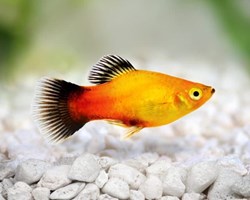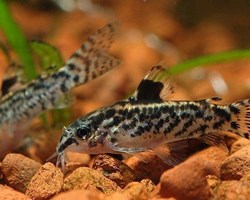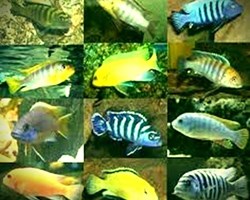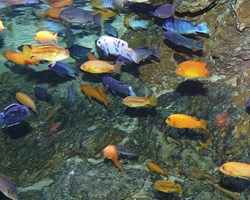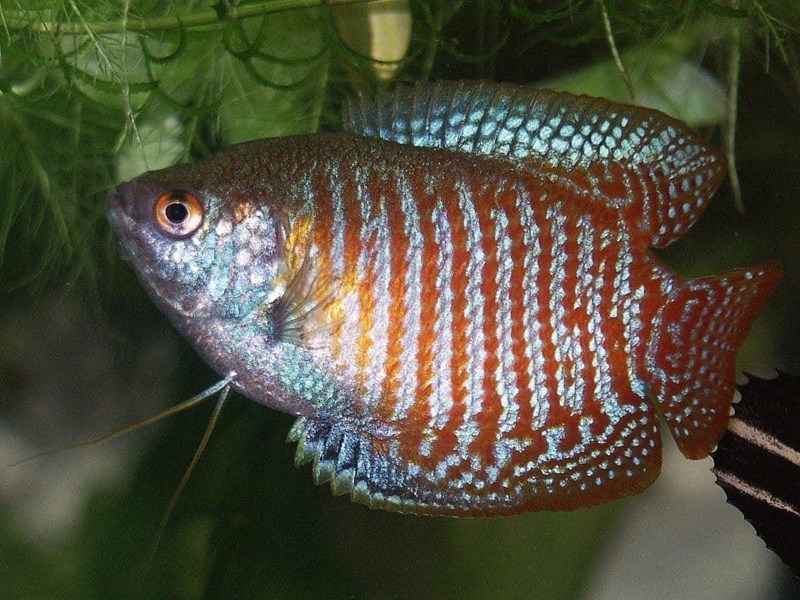
THE ORIGIN OF THE COLISA FISH OR DWARF GURAMI:
The colisa fish, of the order of the perciformes, belongs to the same family of the Gouramis (Osphronemidae).
Its natural habitat is in the rice fields and still waters of Asia, especially in Bangladesh and northeast India.
The Trichogaster lalius, (Hamilton, 1822), formerly Colisa lalia or Dwarf Gourami, was first imported in 1903.
It is native to lowlands in northern India.
During the monsoon season, in summer, they live in flooded areas. It is in these provisional water zones that tend to reach high temperatures that they reproduce.
Over time, different varieties of Dwarf Gourami have been appearing in shades of blue, rainbow, neon and perhaps the most popular is red.
There is another smaller similar species with the name Trichogaster chuna (Hamilton, 1822) with which we should not confuse.
Males reach sizes of up to 7 cm.
Females are a little bit smaller.
THE GENERAL CHARACTERISTICS OF THE DWARF GURAMI:
Common name: Dwarf gourami, Colisa dwarf.
Family:
• Order: Perciformes.
• Family: Osphronemidae. (Guramis).
• Subfamily: Luciocephalinae (until 2005 it was framed in the Trichogastinae subfamily.
Calm waters and rice fields of Asia.
Body compacted by the lateral flanks with a rounded layout.
It has a pair of tactile barbels at the base of the belly.
The coloration of the Dwarf Gourami is very varied.
The most common is characterized by electric blue stripes on a red background that covers the entire body, the fins are red with blue specks. The females generally have a silver color.
Its size is up to 6 cm.
The female is smaller than the male, he has the anal fin with a pointed ending, in most cases the females are less colorful and showy.
The difference between the sexes is significant since the males show very colorful tones while the females wear more discreet liveries that mix grayish and brown tones.
In reality, the tonality of the females corresponds more to the original of the species.
The male also has pointed dorsal and anal fins while the female has a rounded shape.
Their life expectancy is 2-3 years.
Temperature: 24-28°C.
Water: pH: 6.0 to 7.5, GH: 7°d - 15°d.
THE DISTRIBUTION OF THE DWARF GURAMI:
He is from Northeast India and Bangladesh.
THE TYPES OF SPECIES:
MALE COLISA:
Easily recognized by its striking electric blue stripes, which rest on a red body with fins, usually longer, including blue spotting on males.
It is a very peaceful species but, in the case of males, they tend to be a bit aggressive, so it is recommended to keep a couple.
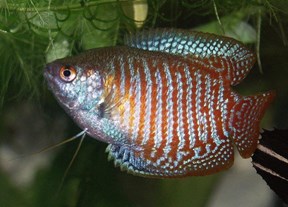
FEMALE COLISA:
To differentiate the Colisa Lalia female, it is enough to see her skin tone.
It has a bright silver color with fins shorter than those of the male.
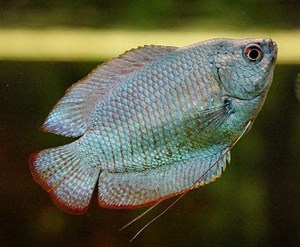
COLISA CHUNA:
Of Indian origin, the Colisa Chuna fish lives under temperatures that range between 22 and 30°C.
This strain loves warm, shallow water as well as plenty of vegetation to move through.
COLISA CHUNA YELLOW:
Among the subspecies of this variety, the Colisa Chuna Dorada or Amarilla fish also stands out, which eats all kinds of food.
It can reach up to 5 cm long.
If you want it as a pet, you should consider that it will be happier in an aquarium of between 30 and 60 liters.
You should also include algae and lower the tide level to the minimum possible to avoid stress.
COLISA CHUNA RED:
These specimens are the majority with respect to the previous option, in addition to being more distributed throughout the planet, especially Colombia and the USA.
It requires the same care as the gilthead.
Its body is covered in red, crowning its upper and rear fins with a greenish hue.
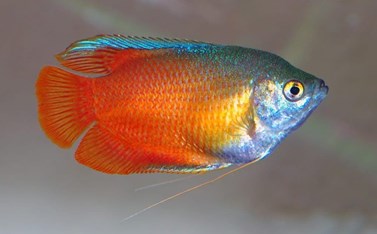
BLUE COLISA:
The blue Colisa fish is one of the most beautiful varieties that we can find.
It does not exceed 4cm in length and can be seen in the river systems of Jamuna, Brahmaputra and Ganges.
They tend to move more through swamps or sections of river with little current, in addition to shallow pools for their normal life.
COLISA FASCIATA:
This is one of the largest varieties of the Colisa fish family, reaching up to 12 cm.
It lives in various areas of India, Asma, Burma and Bengal, reaching Malaya.
The bubble nest built by the male can be up to 10 cm wide.
The males are almost black in color, while the females are smaller and have rounded fins.
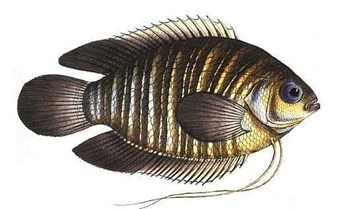
DWARF COLISA.
Only 5 cm long, the dwarf colisa has its ventral fins turned into two long whiskers of its own.
You can get them in silvery blue or greenish gray colors.
There are also specimens with purple lines of different shades.
It prefers dry food and should be supplemented with diets based on natural foods.
THE BEST CARE FOR YOUR AQUARIUM:
From 30 liters, well planted, where floating plants are appreciated.
The current should be reduced to a minimum, since being these fish of calm waters, the excess current stresses them.
The aquarium to keep Colisas apart from the community one with peaceful species is from 100 liters where we can keep a group of three males and six females.
It is preferable to install dark substrates composed of sand or fine gravel so that it does not reflect light.
It is important to provide the aquarium with enough natural plants where the females can take refuge from the persecution of the males.
It is advisable to keep floating plants such as Nymphae (Water Lily), Ceratophyllum demersum, Riccia fluitans or similar.
The little Gouramis establish territories on the surface that they will tenaciously defend during the mating season.
These floating plants or attached to decorative objects allow different territories to be delimited in case of keeping several males. The light moderated or attenuated by the floating plants allow a less shy attitude of the specimens.
We can keep them in water of medium or hard hardness.
It is suitable for not distorting the floating plant sieve not to break the surface with the filter outlet flute.
Temperature for these species between 26 and 28ºC.
We can complement the aquarium with species of small barbels, rasboras and some catfish to give life to the lower and middle areas of the aquarium.
THE REPRODUCTION OF THE TRICHOGASTER LALIUS:
The reproduction of the small Trichogaster is viable even in community aquariums, but the survival of some fry will be occasional.
If we want to reproduce and get the largest number of fingerlings forward, we must propose a suitable facility for breeding.
The signal for the transfer of the pair to the breeding tank is when the male begins to peck small leaves from the plants.
They serve us an aquarium of just 40 liters where we maintain a generous number of plants that withstand the recommended temperature for breeding of 30ºC.
Like other members of the Osphronemidae family, it builds a bubble nest on the surface, so it should not be broken with filters or aerators.
For the construction of the nest, the male uses pieces of Java Moss, strands of peat, Cabomba leaves, Myriophyllum or similar.
During the construction of the nest on the surface, the male is very aggressive, not daring to approach the female.
The male Colisas take their time to build the nest, which often causes the female to become impatient and begin to lightly touch it in the ventral area.
Once the nest is ready, the male changes his attitude towards the female and instead of frightening her off, he begins courtship.
Once the female is ready to lay, the couple intertwines, leaving the female upside down, with the ventral area towards the surface.
In this position, spawning occurs, the male immediately fertilizing the eggs and transporting them to the nest.
Once deposited, it covers them with more bubbles.
Once the laying is finished, the female must be removed from the breeding tank since the male will not tolerate her approaching the nest.
The numerous offspring, between 400 and 700 individuals, hatch 24 hours later, remaining in the nest for two or three more days. When they begin to leave the bubble nest it is time to remove the male.
The larvae should be fed with rotiferous infusoria or paramecia, not accepting newly hatched artemia nauplii until the first 10 days.
During the first four weeks the fry only use the gills to breathe.
It will not be until the end of this time when they rise to the surface, a sign that they have already formed their own respiratory organ called the labyrinth.
It is time to carry out the unpleasant task of selecting those specimens with more color and removing those that do not have it or have a weaker appearance.
It is, like most labyrinths, a bubble nest builder.
Reproduction is possible in a community aquarium, although it is recommended that it be done in an aquarium predisposed for it, of at least 15 liters and with a water height of about 15 cm, with abundant floating plants and a hiding place for the female.
The male and female should be separated if possible and provided with good quality food, preferably live, at least during the week prior to reproduction, after this time, when the male has recognized the place and established his territory, he will begin to build a bubble nest of about 4 x 4 cm. and it will be time to introduce the female, who will be courted in a not very gallant way, so a place where she will take refuge from harassment will be necessary.
At the time of mating, the male will surround the female with his body and press her to release the spawn that will immediately be fertilized and placed in the nest.
This operation will occur several times and when it is finished, the male will attack the female, so she must be quickly removed.
The male will be left in this tank until the fry are swimming by themselves, approximately until the fourth day after hatching, unless he eats the offspring, removing him immediately.
As soon as the young are left alone, the water level should be lowered to 2-5 cm.
The fry should be fed from the second day of life with recently hatched brine shrimp and/or infusoria.
FOR YOUR BEST CARE YOU MUST KNOW ITS BEHAVIOR AND COMPATIBILITY:
It is a very peaceful and sometimes shy fish, as with the other members of its family, the males fight for territory, so they must be kept in pairs or groups with only one male.
THE BEST FEEDING OF THE DWARF GURAMI:
Omnivore, eats any type of food, as long as it is suitable for the small size of its mouth, dry, freeze-dried, frozen, alive such as insect larvae, algae, etc.
Very important the vegetable contribution in your meals.
This species accepts a very varied diet, which may include scales , pellets or other food preparations indicated for these animals.
Live and flakes or scales; daphnia and tubifex accentuate their colors and they like them very much, although the latter should be ruled out due to the large number of pathogenic organisms it carries, which can infect our fish and us as well.
- AZOO TROPICAL MICRO PELLETS 120ml.
- AZOO TROPICAL MICRO PELLETS 330ml.
- TETRAMIN.
- IT WILL BE VIPAN NATURE.
- NUTRAFIN MAX 38g.(HAGEN).
- NUTRAFIN MAX 77g.(HAGEN).
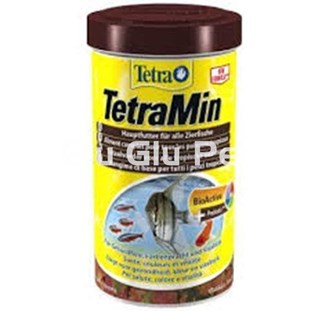
THE BEST CARE FOR THE DWARF GURAMI:
By understanding the habitat in which colisa fish usually move in the wild, it will be more likely that, by offering them a similar environment, we will keep them healthy and for a long time in our aquarium.
These species are easily startled by loud noises and often try to hide.
Unfortunately, sometimes they get into hard to reach places and get stuck.
The worst case scenario is that they get stuck and eventually die, so keep an eye out for this.
It is also important to know that they have an adaptation period. During that period it is especially important not to disturb the fish. It is completely normal for them to act strangely or not be very active during this time.
The ambient temperature and the temperature of the water in the tank should not differ significantly.
In the event that there is a big difference between the two, Gouramis can damage their labyrinthine organ.
If you find yourself in that situation, put a lid on your tank to trap the hot air.
As hardy as these fish may seem, they are still very sensitive to water quality.
If the quality of their living environment is overlooked, Dwarf Gouramis can easily become ill.
THE DISEASES OF COLISA LALIA:
Dwarf gouramis disease:
Also known as DGD, this disease is unique to Dwarf Gouramis. To date, there are no supplements or other chemicals that can cure this.
DGD is a viral infection that can be detected by fading color and degradation of the fin structure, they may begin to fall off.
The best way to make sure this doesn't happen is to closely monitor your water parameters and keep them within acceptable ranges.
iridoviruses:
Dwarf Gourami Iridovirus (DGIV) is a serious infectious disease that in most cases leads to the death of fish. As in the case of DGD, there are no known treatments.
Of all the factors that affect susceptibility to disease, most can be controlled.
First of all, water quality is key to having healthy fish.
This will ensure that your immune system is strong. Second, a good and complex diet is a wonderful prevention.
The Dwarf Gourami or Colisa lalia is one of the most popular freshwater fish: Its small size, its intense and striking color and its peaceful attitude towards other species play an important role in its presence in a large number of freshwater aquariums.
Despite its popularity, this fish is imported less frequently as it suffers from a serious immunodeficiency disorder that ends its life unpleasantly and prematurely.
Asian farms are the ones with the most infection problems, and since this is where these fish come from, their presence has sharply decreased in stores, aware of this devastating disease that affects them.
Although the Iridovirus is not contagious, its lethal capacity makes many wonder if it is worth keeping a fish that has proven to be so delicate.
The term Iridovirus is used to designate five genera of viruses belonging to the Iroviridae family, a group of infectious agents that especially affects insects but also occurs in fish and amphibians, especially frogs.
In particular, the cause of Dwarf Gourami Iridoviriasis, like human AIDS, remains latent in the body of the affected fish for a short period, a year or a little more than average, but in some rare cases it has never been reached. to develop, to then begin its reproductive phase that ends with the life of the sick fish.
The cause of the infection is totally unknown since it is not known how the first infected specimens contracted it.
What is known is that it is hereditary, that is, the offspring of carrier or diseased fish carry the genes of this virus in their own genome.
So, really, what is known as a virus is actually a certain genetic sequence that, being found in the genome of the dwarf gourami, is capable of replicating at any time, producing the tragic disease that kills the affected fish.
This disease is not contagious and exclusively affects the Dwarf Gourami, although similar symptoms have been seen in other related fish such as:
- The pearl gourami (Trichogaster leeri).
- The Blue Gourami (Trichogaster trichopterus).
- The samurai gourami (Sphaerichthys vaillanti).
The symptoms of this disease are very varied and Iridoviriasis can easily be confused with other infectious diseases.
The only way to be sure a Gourami is suffering from this problem is if it is the only fish in the tank showing symptoms while the others are fine.
After the latency period, minor symptoms appear that are sometimes difficult to observe: The affected fish moves and eats less, begins to lose weight slowly and its fins remain retracted for quite some time, although other specimens may not present these initial signs.
Round white spots can then be seen all over the body of the fish, which later turn into a well visible round cyst that evolves into a severe ulcer that is easily infected.
Subcutaneous lumps and exaggerated bulging of the belly can also be seen in some cases, which may be accompanied by Dropsy.
During this phase, the immune system of the fish weakens so much that it is affected by multiple diseases (white spot, Oodinium, Hexamita, ..., until it reaches the point where feeding stops completely, the weight loss is severe and the fish ends up dying. irremediably within a period of 10 - 12 months from the appearance of the first symptoms.
The serious problem with this disease is that there is no curative treatment or preventive methods given that, being hereditary and of unknown origin, it is not possible to know which specimen is a carrier until the symptoms appear.
If, after some time after the first symptoms appear, the affected fish is in an unfortunate state, it is best to sacrifice it to avoid unnecessary suffering.
Some specimens swim and eat normally even with all the symptoms listed above, but it is not usual.
The general recommendation is that it is better not to install this species in a private aquarium if it comes from an Asian hatchery.
Unfortunately, until now they are the ones that export them to the rest of the world, so fewer and fewer copies are seen in stores.
It is to be hoped that, in the near future, hatcheries in other countries will be able to start reproducing this species on an industrial scale, which for many years has been an indisputable inhabitant of many community aquariums and is one of the jewels of the aquarium hobby in sweet water.
The ideal aquarium for a colisa fish should be at a height that reaches a maximum of 35-40 cm.
The pH of the water must be between neutral and slightly acidic (6.8-7), in addition to having a maximum hardness of 10 dH.
In addition, due to its particular respiratory system, it is convenient to use an aquarium with a hermetically sealed lid.
The presence of vegetation will be key to guaranteeing their well-being, as well as the choice of the most appropriate elements, those that evoke the Indo-Malaysian areas, always leaving a minimum space for their free movement throughout this structure.
THE BEST LIGHTING FOR DWARF GURAMI:
The best way to illuminate the colisa fish aquarium is through a lamp of between 30 and 40 watts placed about 10 cm above the lid to avoid excessive heating.
You can place another auxiliary light, about 15 cm, in case the other one fails, since it is key that they always have light visibility to be able to see their surroundings correctly, especially when the rest of the room is dark.

